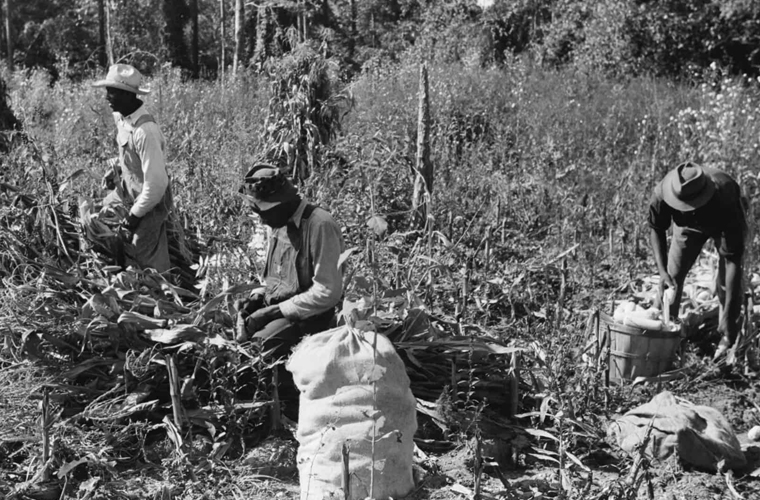Sharecropping was a pivotal agricultural system that took root in the United States, particularly in the Southern states, following the Civil War (1861–1865). Emerging during the Reconstruction era, it became a dominant method of farming in the late 19th and early 20th centuries, especially in the cotton-growing regions of the South. This system shaped the economic, social, and racial dynamics of the post-war South, leaving a lasting legacy that influenced rural life for decades.
Historical Context
After the Civil War, the Southern economy was in disarray. The abolition of slavery through the Thirteenth Amendment in 1865 ended the plantation system that had relied on enslaved labor. Large landowners, facing a shortage of workers and capital, needed a new labor system to maintain agricultural production. Meanwhile, newly freed African Americans and poor white farmers sought ways to earn a living but often lacked the resources to own land or equipment. Sharecropping emerged as a compromise, though it was fraught with inequities that perpetuated economic hardship and racial disparities.
How Sharecropping Worked
In the sharecropping system, landowners provided tenant farmers—often freed African Americans or impoverished white farmers—with access to land, tools, seeds, and sometimes housing. In return, the tenant farmers agreed to give the landowner a portion of the crops they produced, typically ranging from one-third to one-half of the harvest. The specific terms varied depending on the agreement:
- Land and Supplies: Landowners supplied the land and often provided seeds, fertilizers, tools, and mules, as well as necessities like food and clothing, on credit.
- Labor and Crop Division: Tenant farmers worked the land, planting, tending, and harvesting crops, with cotton being the primary crop in the South. At harvest time, the crop was divided, with the landowner receiving their agreed-upon share.
- Debt Cycle: Many sharecroppers were required to purchase supplies from the landowner or local merchants on credit. High interest rates and inflated prices often trapped sharecroppers in a cycle of debt, as their share of the crop was insufficient to cover expenses, forcing them to borrow again for the next season.
Prevalence and Economic Impact
Sharecropping became widespread in the Southern states, particularly in regions like Georgia, Alabama, Mississippi, and the Carolinas, where cotton production dominated. By the late 19th century, it was the primary labor system for Southern agriculture. While it allowed landowners to maintain control over their land and labor force, it often kept tenant farmers in a state of economic dependency. The system discouraged crop diversification, as landowners prioritized cash crops like cotton, which depleted soil fertility and increased reliance on a single market.
Social and Racial Dynamics
Sharecropping had profound social and racial implications. For African American sharecroppers, the system often replicated the exploitation of slavery, as they faced discriminatory practices, such as unfair crop settlements or manipulated account books. White sharecroppers, though also economically disadvantaged, sometimes received better terms than their Black counterparts. The system reinforced racial hierarchies, as landowners, who were predominantly white, held significant power over tenants. The lack of economic mobility in sharecropping contributed to systemic poverty in the South. Sharecroppers rarely accumulated enough wealth to purchase land, and the debt cycle kept many families trapped in a precarious existence. This economic stagnation also fueled tensions between racial groups and contributed to social unrest in rural areas.
Decline of Sharecropping
Sharecropping began to decline in the early 20th century due to several factors:
- Mechanization: The introduction of tractors and other machinery reduced the need for manual labor.
- Economic Shifts: The Great Depression and the New Deal’s agricultural policies, such as the Agricultural Adjustment Act (AAA) of 1933, incentivized landowners to reduce tenant farming.
- Migration: The Great Migration saw millions of African Americans leave the rural South for urban areas in the North and West, seeking better economic opportunities and escaping discriminatory practices.
- Crop Diversification: The push for soil conservation and crop diversification reduced reliance on cotton, altering the economic viability of sharecropping.
By the mid-20th century, sharecropping had largely faded, though its legacy persisted in the form of entrenched poverty and racial inequities in the South.
Legacy and Significance
Sharecropping was more than an agricultural arrangement; it was a system that shaped the social, economic, and political landscape of the post-Civil War South. While it provided a temporary solution for landowners and laborers, it often perpetuated exploitation and limited opportunities for economic advancement, particularly for African Americans. The system’s reliance on debt and cash crops contributed to long-term environmental and economic challenges in the region. Today, sharecropping is studied as a critical chapter in American history, illustrating the complexities of Reconstruction, the persistence of racial and economic inequalities, and the challenges of transitioning from a slave-based economy to a free labor system. Its impact can still be seen in the socioeconomic disparities that linger in parts of the rural South.


